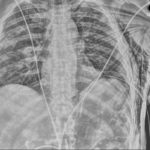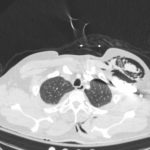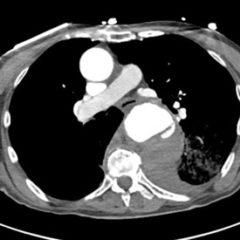Subcutaneous Emphysema After Chest Trauma
History of present illness:
A 52-year-old male presented to the emergency room with left chest wall pain and upper back pain after falling from an estimated height of 24 feet, landing on his back. On physical exam, the patient had crepitus to left chest wall and back and was persistently hypotensive in the trauma bay.
Significant findings:
Plain film anteroposterior (AP) radiography of the chest shows left-sided subcutaneous emphysema (red arrow) with overlapping muscle striations of the pectoralis major (green arrow). After chest tube placement (blue arrow), AP chest radiography shows persistent left-sided subcutaneous emphysema (red arrow). CT of the chest shows pneumomediastinum (blue arrow), left apical pneumothorax (pink arrow), and subcutaneous emphysema (red arrow) at the level of T2. At the level of T6, rib fractures can be visualized on the CT (yellow arrow). At the level of T8, left sided pneumothorax is also seen (pink arrow) as the absence of lung tissue on CT.
Discussion:
Injuries of the thorax account for 25% of all mortality in trauma patients, of which many are preventable deaths by simple interventions.1,2 One sign commonly seen in patients with chest trauma is subcutaneous emphysema. The presence of this underlying emphysema has been suggested to be a sign of injury to the respiratory tract, making it clinically significant.3,4 Specifically, subcutaneous emphysema has been shown to be a clinical predictor of occult pneumothorax, with an odds ratio of 5.47.3 Furthermore, these injuries to the respiratory tract (pneumothorax /hemothorax, pneumomediastinum, etc.) can lead to hemodynamic instability and respiratory failure.4-6
Treatment of these injuries consist of different measures. Subcutaneous emphysema does not usually require treatment and will reabsorb spontaneously.7 Pneumothorax and hemothorax are both treated with chest tube placement. In a hemothorax, however, if the tube evacuates more than 1,500 mL of blood immediately or more than 200 mL/hour, the patient should be taken to the operating room for surgical exploration of the chest.8 Therefore, complete investigation into the underlying cause of subcutaneous emphysema is essential in managing patients with chest trauma.
In this patient, given the findings of multiple bilateral rib fractures, bilateral hemothorax/pneumothorax and multiple spine fractures, bilateral chest tubes were placed which had immediate output. The patient was admitted to surgical intensive care unit for chest tube management, pulmonary hygiene and further management of his other injuries.
Topics:
Subcutaneous emphysema, chest trauma, pneumothorax, pneumomediastinum.
References:
- Livingston DH, Hauser CJ. Trauma to the chest wall and lung. In: Moore EE, Feliciano DV, Mattox KL, eds. 5th ed. New York, NY: McGraw-Hill; 2003:507-537.
- Stocchetti N, Pagliarini G, Gennari M, et al. Trauma care in Italy: evidence of in-hospital preventable deaths. J Trauma.1994;36(3):401–405.
- Ball CG, Ranson K, Dente CJ, Feliciano DV, Laupland KB, Dyer D, et al. Clinical predictors of occult pneumothoraces in severely injured blunt polytrauma patients: a prospective observational study. I 2009;40(1):44-47. doi: 10.1016/j.injury.2008.07.015
- Liman ST, Kuzucu A, Tastepe AI, Ulasan GN, Topcu S. Chest injury due to blunt trauma. Eur J Cardiothorac Surg. 2003;23(3):374-378.doi: 10.1016/s1010-7940(02)00813-8
- Blaivas M, Lyon M, Duggal S. A prospective comparison of supine chest radiography and bedside ultrasound for the diagnosis of traumatic pneumothorax. Acad Emerg Med. 2005;12(9):844-849. doi: 10.1197/j.aem.2005.05.005
- Pitukweerakul S, Pilla S. Massive subcutaneous emphysema. J Gen Intern Med.2016;31(6):700-701. doi: 10.1007/s11606-015-3581-2
- Mattox K, Allen MK. Systematic approach to pneumothorax, hemothorax, pneumomediastinum and subcutaneous emphysema. Injury. 1986;17(5):309-312. doi: 10.1016/0020-1383(86)90152-X
- Mowery NT, Gunter OL, Collier BR, Diaz JJ Jr, Haut E, Hildreth A, et al. Practice management guidelines for management of hemothorax and occult pneumothorax. J Trauma.2011;70:(2)510-518. doi: 10.1097/TA.0b013e31820b5c31














